| SILKYPIX® Developer Studio 4.0 | SOFTWARE MANUAL |
| 3. Display modes and scene operations | ||||||||
Displaying scenes for processing is done in two types of display windows.
The first is a "Thumbnail window" that displays a list of scenes for processing. The other is a "Preview window" for large display of only one selected scene.
The first is a "Thumbnail window" that displays a list of scenes for processing. The other is a "Preview window" for large display of only one selected scene.
Three display modes are available in SILKYPIX® Developer Studio 4.0 through the combination of these two kinds of windows.
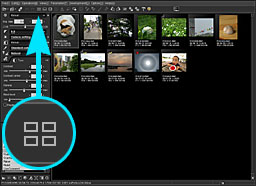
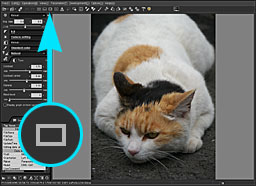
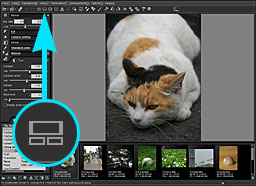

| (1) | Thumbnail Mode |
The thumbnail display mode is a display mode in which the "Thumbnail window" is located in the main window and the preview window is not displayed.

| (2) | Preview Mode |
The preview display mode is a display mode in which the "Preview window" is located in the main window and the thumbnail window is not displayed.

| (3) | Combination Mode |
The "combination mode" is a mixed mode of the "thumbnail mode" and "preview mode", displaying Thumbnails and single view at the same time. You can select a format that displays both in the main window or a format that displays the "Thumbnail window" outside of the main window as a separate floating window.
3.1. Switching Display Modes
Switching to "Thumbnail Display Mode," "Preview Display Mode" and "Combination Display Mode" can be performed at any time with [Display (V)] in the menu or with the tool bar icon.
If you double click a selected scene in "Thumbnail Display Mode," it will switch to "Preview Display Mode."
If you double click a selected scene in "Thumbnail Display Mode," it will switch to "Preview Display Mode."
3.2. Preview window
The "Preview Window" is a window for displaying preview images of selected scenes.
By opening a preview image of a selected scene, you can view the entire image or enlarge just one part to check it.
By opening a preview image of a selected scene, you can view the entire image or enlarge just one part to check it.
3.2.1. Changing operation modes and display position / magnification
The preview display comes with functions for changing display position and magnification for checking parts of the image, as well as functions for making adjustments to development parameters with the mouse in the preview display.
The aims of mouse operations in the preview display are switched in "Operation mode."
In "Operation mode," there are two types of tools, one type that changes display position and magnification and another type that makes adjustments to development parameters.
Be sure to select one of the following operation modes for changing display position and magnification: "Fit display," "Zoom tools," "Loupe tools [Enlarge +]," "Loupe tools [Reduce -]" and "Palm tools."
"Fit display" is a mode that fits the entire image in the display. The other four tools can be used to change display position and magnification through their own methods.
The aims of mouse operations in the preview display are switched in "Operation mode."
In "Operation mode," there are two types of tools, one type that changes display position and magnification and another type that makes adjustments to development parameters.
Be sure to select one of the following operation modes for changing display position and magnification: "Fit display," "Zoom tools," "Loupe tools [Enlarge +]," "Loupe tools [Reduce -]" and "Palm tools."
"Fit display" is a mode that fits the entire image in the display. The other four tools can be used to change display position and magnification through their own methods.
There are seven kinds of tools for changing development parameters, including "Exposure bias tools," "Gray balance tools," "Skin color designation tools," "Rotation tools," "Magnified color aberration correction tools," and "Set trimming area."
You can select one of these, or select none of them. These tools are used together with operation modes that change display position and magnification.
You can select one of these, or select none of them. These tools are used together with operation modes that change display position and magnification.
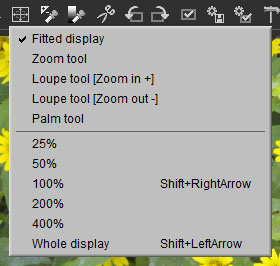 3.2.1.1. Changing preview display position and magnification
3.2.1.1. Changing preview display position and magnification There are several ways to change preview display position and magnification.
Methods other than changes through mouse operations on the preview display will be explained here.
3.2.1.2. Change display position / magnification with the mouse Methods other than changes through mouse operations on the preview display will be explained here.
| (1) | Change display magnification from the menu |
Click on the preview display mode icon on the tool bar, and a menu will be displayed for changing operation modes and display magnification in the preview display.
Also, items for changing display magnification are enumerated in a submenu opened from [Display (V)] [Display magnification (V)] from the menu and in a context menu displayed by right clicking on the preview window.
Display magnification can be changed from these menus.
Also, items for changing display magnification are enumerated in a submenu opened from [Display (V)] [Display magnification (V)] from the menu and in a context menu displayed by right clicking on the preview window.
Display magnification can be changed from these menus.
| Whole display | Magnify display so that the entire image fits into the display area. |
| 100%(0) | Display magnification (per pixel) so that one dot of developed RAW data is one dot on the display. |
| 25%(1) 50%(2) 200%(5) 400%(7) | Change display magnification to each setting. |
| Zoom in + | Adjust magnification to enlarge one step from the current display magnification. |
| Zoom out - | Adjust magnification to reduce one step from the current display magnification. |
| (2) | Change display magnification with the slider control |
In "Operation modes" other than "Fit display," a slider control for changing display magnification is displayed at the bottom of the preview display.
The slider control is composed of three controls, the slider, a dropdown list and a text box. You can set display magnification using these.
The slider control is composed of three controls, the slider, a dropdown list and a text box. You can set display magnification using these.
| (3) | Change display position with the scroll bar |
In "Operation modes" other than "Fit display," vertical and horizontal scroll bars are displayed to the right and at the bottom of the preview display.
You can adjust the display position using these.
You can adjust the display position using these.
The relationship between mouse operations and functions in the preview display are determined by the operation mode. There are five operation modes: "Fit display," "Zoom tools," "Loupe tools [Enlarge +]," "Loupe tools [Reduce -]" and "Palm tools."
The following explains how to change display location / magnification in each operation mode.
 "Zoom tools" is a convenient operation mode in which you can enlarge or reduce the preview display instantly, and can change the displayed position. Both "Loupe tools" and "Palm tools" have these functions.
"Zoom tools" is a convenient operation mode in which you can enlarge or reduce the preview display instantly, and can change the displayed position. Both "Loupe tools" and "Palm tools" have these functions.
Once you master these operations, you can change the size and position of the preview display very quickly.
 The "loupe tool [zoom in(+)]" offers a convenient mouse operation mode that can enlarge the image, with the center of enlargement being at the clicking point.
The "loupe tool [zoom in(+)]" offers a convenient mouse operation mode that can enlarge the image, with the center of enlargement being at the clicking point.
Since this mouse operation has been adopted by a lot of other applications, it appears familiar to many users.
When you operate this tool while pressing the [ALT] key, [zoom in(+)] does not work but [zoom out(-)] works.
 The "loupe tool [zoom out(-)]" offers a convenient mouse operation mode that can reduce the image with the center of reduction being at the clicking point.
The "loupe tool [zoom out(-)]" offers a convenient mouse operation mode that can reduce the image with the center of reduction being at the clicking point.
Since this mouse operation has been adopted by many other applications, it appears familiar to many users.
When you operate this tool while pressing the [ALT] key, [zoom out(-)] does not work but [zoom in(+)] works.
 The palm tool offers a mouse operation mode that can grab and move a picture (panning operation). This operation similar to the mouse operation mode adopted by many other software.
The palm tool offers a mouse operation mode that can grab and move a picture (panning operation). This operation similar to the mouse operation mode adopted by many other software.
In addition, when you click on a picture while pressing the [CTRL] key, the picture size is enlarged with the center of enlargement being at the clicking point.
When you click on a picture while pressing the Alt key, the picture size is reduced with the center of reduction being at the clicking point.
The following explains how to change display location / magnification in each operation mode.
| (1) | Fitted Display |
In this mode, the entire scene is displayed so as to fit the scene to the preview window. When resizing the window, its display magnification changes automatically according to the window size.
In this mode, you can execute the following mouse operation
Changing display magnification is possible from the menu, even if the operation mode is "Fit display." If the display magnification is changed, the operation will automatically switch to "Zoom tools."
In this mode, you can execute the following mouse operation
| Left Double-click | ... | Display magnification becomes 100% and the "zoom tool" is selected |
| [SHIFT] + Left-Drag | ... | The "zoom tool" is selected and you can change display magnification continuously. |
Changing display magnification is possible from the menu, even if the operation mode is "Fit display." If the display magnification is changed, the operation will automatically switch to "Zoom tools."
| (2) | Zoom Tool |
 "Zoom tools" is a convenient operation mode in which you can enlarge or reduce the preview display instantly, and can change the displayed position. Both "Loupe tools" and "Palm tools" have these functions.
"Zoom tools" is a convenient operation mode in which you can enlarge or reduce the preview display instantly, and can change the displayed position. Both "Loupe tools" and "Palm tools" have these functions.Once you master these operations, you can change the size and position of the preview display very quickly.
| Left-Drag | ... | You can grab and move a picture (panning operation). |
| Left Double-Click | ... | When display magnification is at 100%, the magnification is changed so that the whole image fits on the window (full display). When the display magnification is at other than 100%, the magnification is returned to 100% at which developed pixels are the same as those on the window. Thus, only by left double-clicking, you can switch a magnification value between full display and 100%. This turns out to be a very convenient function. |
| [SHIFT] + Left-Drag | ... | You can change display magnification continuously, with the center of changing being at the drag-starting point. You can instantly enlarge or reduce the portion when you want to check in detail. This is very helpful. |
| (3) | Loupe Tool [Zoom In +] |
 The "loupe tool [zoom in(+)]" offers a convenient mouse operation mode that can enlarge the image, with the center of enlargement being at the clicking point.
The "loupe tool [zoom in(+)]" offers a convenient mouse operation mode that can enlarge the image, with the center of enlargement being at the clicking point.Since this mouse operation has been adopted by a lot of other applications, it appears familiar to many users.
When you operate this tool while pressing the [ALT] key, [zoom in(+)] does not work but [zoom out(-)] works.
| Left-Click | ... | Zoom In |
| [ALT] + Left-Click | ... | Zoom Out |
| (4) | Loupe Tool [Zoom Out -] |
 The "loupe tool [zoom out(-)]" offers a convenient mouse operation mode that can reduce the image with the center of reduction being at the clicking point.
The "loupe tool [zoom out(-)]" offers a convenient mouse operation mode that can reduce the image with the center of reduction being at the clicking point.Since this mouse operation has been adopted by many other applications, it appears familiar to many users.
When you operate this tool while pressing the [ALT] key, [zoom out(-)] does not work but [zoom in(+)] works.
| Left-Click | ... | Zoom Out |
| [ALT] + Left-Click | ... | Zoom In |
| (5) | Palm Tool |
 The palm tool offers a mouse operation mode that can grab and move a picture (panning operation). This operation similar to the mouse operation mode adopted by many other software.
The palm tool offers a mouse operation mode that can grab and move a picture (panning operation). This operation similar to the mouse operation mode adopted by many other software.In addition, when you click on a picture while pressing the [CTRL] key, the picture size is enlarged with the center of enlargement being at the clicking point.
When you click on a picture while pressing the Alt key, the picture size is reduced with the center of reduction being at the clicking point.
| Left-Drag | ... | You can grab and move a picture (panning operation). |
| [CTRL] + Left-Click | ... | Zoom In |
| [ALT] + Left Click | ... | Zoom Out |
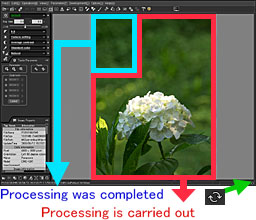 The preview display in the preview window can perform concurrent processing in two formats, a simple preview display that performs simple development processing for quick display of the whole, and the formal development preview display for development processing the exact same as the output image of development results.
The preview display in the preview window can perform concurrent processing in two formats, a simple preview display that performs simple development processing for quick display of the whole, and the formal development preview display for development processing the exact same as the output image of development results.If you need to update the preview display, first use the quick simple preview display. In the background, parallel processing of partial formal development is performed at the same time. It is updated as display blocks that have completed formal development processing are automatically replaced.
If selected scenes are switched and development parameters are changed, it may seem at first that the image display is a little rough, but you will understand as details of the image change in order.
When changing development parameters, it is possible to confirm the process at different stages displayed in the simple preview without having to check the results of formal development.
In the "Outline Preview", only the outline processing which is shown below is performed to speed up.
| (1) | It processes partially culled RAW data according to the display size, and executes a first and simple demosaic process. Therefore, there are sometimes some jaggy and false colors around the outline. (In the "Formal Development", the entire RAW data are processed and a complete demosaic process and false color control.) is executed |
| (2) | It does not process noise reduction, false color control, sharpness, and other frequency surface filter processing. Therefore, when you modify the parameter "sharpness", "noise reduction", "demosaic sharp", "resolution plus", or "false color ctrl.", the "preview image" will not be updated during "Outline Preview". (In the "Formal Development", it processes all filters and the effect of the modified parameter is reflected on the display.) |
It processes data as well as the "Formal Development" except for the above description. Therefore, "exposure bias", "white balance", "tone", and "saturation" is reflected also in the "Outline Preview".
3.2.3. Formal Development Preview
 Until "Formal Development" has been completed, two types of "preview images" are intermingled.
Until "Formal Development" has been completed, two types of "preview images" are intermingled.While the
 mark is displayed at the right end of the statusbar, it indicates that the "Formal Development" is still under operation and there still remains the result of "Outline Preview".
mark is displayed at the right end of the statusbar, it indicates that the "Formal Development" is still under operation and there still remains the result of "Outline Preview".When "Formal Development" is completed, the
 mark disappears and it indicates that the whole "preview image" has been replaced to "Formal Development Preview". Then you can check the final development result on the screen.
mark disappears and it indicates that the whole "preview image" has been replaced to "Formal Development Preview". Then you can check the final development result on the screen.If you check 'Make operation comfortable by reducing the load' on the display setting dialog, "Formal Development Preview" is not displayed when displaying preview image smaller than 100%. And the parameter adjustment becomes able to be lightly done.
It provides you to reduce the memory cunsumption and the load of CPU when updating a preview image.
This setting is effective for the PC that has few built-in memories (less than roughly 1GB) or a notebook PC. Please refter to '9.2.4 Preview Mode'.
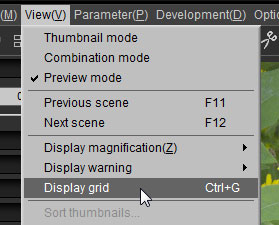 3.2.4. Grid Display
3.2.4. Grid Display You can display the grid on the preview image in the "Preview mode" or "Combination mode".
Selecting the menu command [View(V)]-[Display grid] turns the grid on or off.
Even when the grid display is OFF, the grid will be automatically displayed for a set time period while adjusting the "Rotation / Digital shift" category in development parameters.
Please refer to "9.2.4.3. Grid settings" concerning settings in this function.
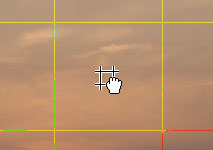 3.2.4.1. Moving Grid Position
3.2.4.1. Moving Grid Position
 3.2.4.2. Grid Setting
3.2.4.2. Grid Setting
Selecting the menu command [View(V)]-[Display grid] turns the grid on or off.
Even when the grid display is OFF, the grid will be automatically displayed for a set time period while adjusting the "Rotation / Digital shift" category in development parameters.
Please refer to "9.2.4.3. Grid settings" concerning settings in this function.
 3.2.4.1. Moving Grid Position
3.2.4.1. Moving Grid Position On the Preview window, you can grab and move the grid by the [CTRL] key + drag operation.
In addition, the [CTLR] key + left-double-clicking reset the grid to the initial position.
In addition, the [CTLR] key + left-double-clicking reset the grid to the initial position.
 3.2.4.2. Grid Setting
3.2.4.2. Grid Setting While displaying the grid, the "Grid setting" dialog appears in the default setting.
You can configure the interval and position of the grid on the dialog, and reset the grid to the initial position, too.
You can configure the interval and position of the grid on the dialog, and reset the grid to the initial position, too.
| (1) | Grid interval | Use the slider to adjust the grid intervals. |
| (2) | Move grid | When you click the  icon, the operation mode is changed to the "moving grid" mode and the mouse cursor is changed to icon, the operation mode is changed to the "moving grid" mode and the mouse cursor is changed to  . .You can grab and move the grid by dragging. Once you perform the operation in the moving grid mode, the operation mode is returned to the previous mode automatically. |
| (3) | Initialize grid position | When you click the  icon, the grid position is initialized. The grid interval is not changed by this operation. This feature is valid only in a status where a grid position is customized. icon, the grid position is initialized. The grid interval is not changed by this operation. This feature is valid only in a status where a grid position is customized. |
3.3. Thumbnail window
You can select multiple scenes and perform operations on selected multiple scenes as a batch in the thumbnail window.
3.3.1. Selecting Multiple Scenes
3.3.1. Selecting Multiple Scenes
When you left-click on a scene while pressing the [CTRL] key, you can select the scene keeping other scene selected. If you repeat this operation, you can select multiple arbitrary scenes.
When you left-click on a scene while pressing the [SHIFT] key, you can select the scenes together from the clicked scene to other selected scene.
When you press the [CTRL] and [A] keys at the same time, or click the menu command [Edit(E)]-[Select all scenes], you can select all the scenes on the window.
You can change the selected scene by using the arrow key.
* While multiple scenes are selected, you cannot change the parameter or switch to the preview mode.
3.3.2. Operation for Multiple Scenes When you left-click on a scene while pressing the [SHIFT] key, you can select the scenes together from the clicked scene to other selected scene.
When you press the [CTRL] and [A] keys at the same time, or click the menu command [Edit(E)]-[Select all scenes], you can select all the scenes on the window.
You can change the selected scene by using the arrow key.
* While multiple scenes are selected, you cannot change the parameter or switch to the preview mode.
For the multiple selected scenes, you can use the context menu operation by right-clicking.
The operations for the multiple selected scenes are "Rotate images", "Apply taste", "Paste/Load parameter", "Batch development", "Print", "File operation" and so on.
The operations for the multiple selected scenes are "Rotate images", "Apply taste", "Paste/Load parameter", "Batch development", "Print", "File operation" and so on.
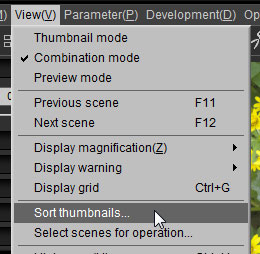 3.3.3. Sorting Thumbnail
3.3.3. Sorting Thumbnail You can specify the display order of the thumbnail.
Using the menu command [View(V)]-[Sort thumbnails ...] or clicking the [Sort thumbnail] button on the "Display setting" dialog.
Set rules for arranging thumbnails in the order you prefer in the "Arrange thumbnails" dialog.
3.3.3.1. Control description

Using the menu command [View(V)]-[Sort thumbnails ...] or clicking the [Sort thumbnail] button on the "Display setting" dialog.
Set rules for arranging thumbnails in the order you prefer in the "Arrange thumbnails" dialog.
3.3.3.1. Control description

| (1) | List of sorting keys |
You can specify the order of the sorting key on this list.
The sorting key is applied in turn from top of the list.
"Ascending order" displays in order from small values to larger values, but if marked, set scenes are displayed first and scenes not set displayed after those.
"Descending order" is displayed in reverse order to "Ascending order."
And you can specify whether ascending order or descending order to each sorting key.
The sorting key is applied in turn from top of the list.
"Ascending order" displays in order from small values to larger values, but if marked, set scenes are displayed first and scenes not set displayed after those.
"Descending order" is displayed in reverse order to "Ascending order."
And you can specify whether ascending order or descending order to each sorting key.
| (2) | Unused sorting key list |
A list of keys that can be added as sorting keys is itemized.
When selecting one key on the list and clicking the (3) button, you can add the key to the bottom of the list of (1).
When selecting one key on the list and clicking the (3) button, you can add the key to the bottom of the list of (1).
| (3) | Add sort key |
When clicking this button, the sort key selected on the (2) list will be added to the bottom of the list of (1).
| (4) | Remove sort key |
When clicking this button, the sort key selected on the (1) list will be removed.
| (5) | To upper |
When clicking this button, the sort key selected on the (1) list will be moved upper of the list..
| (6) | To lower |
When clicking this button, the sort key selected on the (1) list will be moved lower of the list..
3.4. Operations for selected scenes
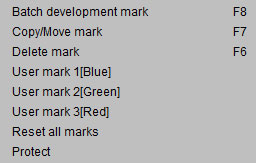 3.4.1. Reservations / Marks
3.4.1. Reservations / Marks You can make reservations /marks for operating and managing scenes.
By right clicking on a thumbnail or preview image, a pop-up menu will appear, from which you can select reservations / marks and cancel set reservations / marks.
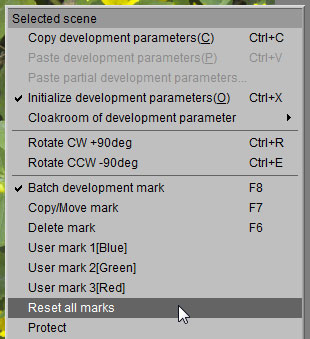 To cancel a reservation / mark set on a scene, right click on a thumbnail of a marked scene to display a context menu.
To cancel a reservation / mark set on a scene, right click on a thumbnail of a marked scene to display a context menu.
Select "Delete all reservations / marks" to delete all set marks and operations.
To cancel individual set marks, select the mark and reservation for deletion from the context menu.
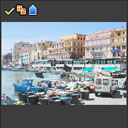 A maximum of five kinds of marks can be set to a single image.
A maximum of five kinds of marks can be set to a single image.
The following combinations can be set.
By right clicking on a thumbnail or preview image, a pop-up menu will appear, from which you can select reservations / marks and cancel set reservations / marks.
| (1) | Delete mark | 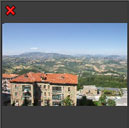 This is a mark added to a scene you want to delete. This is a mark added to a scene you want to delete.After reserving, you can move scenes marked for deletion as a batch to Trash through [File (F)] [Delete scenes marked for deletion (E)] from the menu. |
| (2) | Copy/Move mark | 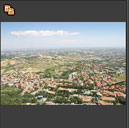 This is a mark added to a scene you want to copy or move. This is a mark added to a scene you want to copy or move.After reserving, you can copy or move scenes marked for copying or moving as a batch through [File (F)] [Copy scenes marked for copying (C)] or [Move scenes marked for moving (M)] from the menu. |
| (3) | Batch development mark | 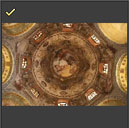 By setting development reservations, you can develop multiple scenes in a batch from [Develop (D)] [Batch develop scenes reserved for development (V)] from the menu. By setting development reservations, you can develop multiple scenes in a batch from [Develop (D)] [Batch develop scenes reserved for development (V)] from the menu. |
| (4) | User mark 1[Blue] |  By setting User mark 1 [Blue], you can use blue marks as tags. By setting User mark 1 [Blue], you can use blue marks as tags. |
| (5) | User mark 2[Green] | 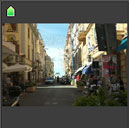 By setting User mark 2 [Green], you can use green marks as tags. By setting User mark 2 [Green], you can use green marks as tags. |
| (6) | User mark 3[Red] | 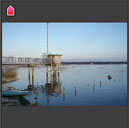 By setting User mark 3 [Red], you can use red marks as tags. By setting User mark 3 [Red], you can use red marks as tags. |
 To cancel a reservation / mark set on a scene, right click on a thumbnail of a marked scene to display a context menu.
To cancel a reservation / mark set on a scene, right click on a thumbnail of a marked scene to display a context menu.Select "Delete all reservations / marks" to delete all set marks and operations.
To cancel individual set marks, select the mark and reservation for deletion from the context menu.
 A maximum of five kinds of marks can be set to a single image.
A maximum of five kinds of marks can be set to a single image.The following combinations can be set.
| (A) | Delete mark or Copy/Move mark |
| (B) | Batch Development mark |
| (C) | User mark 1[Blue] |
| (D) | User mark 2[Green] |
| (E) | User mark 3[Red] |
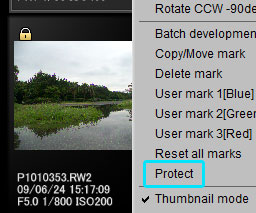 3.4.2. Protect
3.4.2. Protect SILKYPIX protect is not for setting attributes of the RAW data file image for processing.
SILKYPIX protect prohibits moving or deleting files and changing development parameters during SILKYPIX operations.
Protected scenes are displayed with in thumbnail displays and on the status bar.
in thumbnail displays and on the status bar.
To cancel the "Protect" setting, right click on the thumbnail or preview display and use the context menu, or use "Development Settings."
SILKYPIX protect prohibits moving or deleting files and changing development parameters during SILKYPIX operations.
Protected scenes are displayed with
 in thumbnail displays and on the status bar.
in thumbnail displays and on the status bar.To cancel the "Protect" setting, right click on the thumbnail or preview display and use the context menu, or use "Development Settings."
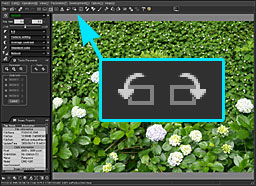 3.4.3. Switching to previous scene
3.4.3. Switching to previous scene If there are multiple scenes being operated on, click on  to go to the scene prior to the currently selected one or on
to go to the scene prior to the currently selected one or on  to go to the next scene.
to go to the next scene.
 to go to the scene prior to the currently selected one or on
to go to the scene prior to the currently selected one or on  to go to the next scene.
to go to the next scene.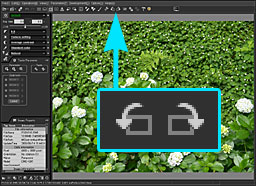 3.4.4. Rotating images
3.4.4. Rotating images Rotate the image of the scene currently selected.
The image is rotated 90degree counterclockwise (-90degree) when you click on and 90degree clockwise (+90degree) when you click on
and 90degree clockwise (+90degree) when you click on  .
.
The image is rotated 90degree counterclockwise (-90degree) when you click on
 and 90degree clockwise (+90degree) when you click on
and 90degree clockwise (+90degree) when you click on  .
.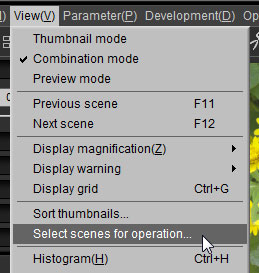 3.4.5. Sorting display of scenes for processing
3.4.5. Sorting display of scenes for processing You can sort and display a part of the scenes for development, such as marked scenes and selected scenes.
There are two ways you can sort scenes.
One method is by selecting [Display (V)] [Sort scenes for development] from the menu and designating sorting conditions from the "Sort scenes for development" dialog. The other is by moving your mouse over the icon located to the lower right of the thumbnail window and designating "1 click sorting" from the sub-control.
icon located to the lower right of the thumbnail window and designating "1 click sorting" from the sub-control.
 You can sort marked scenes and selected scenes with one click in the "1 click sorting" sub-control.
You can sort marked scenes and selected scenes with one click in the "1 click sorting" sub-control.
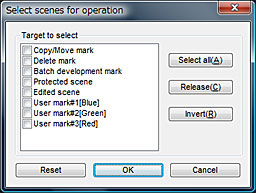 You can sort using more sophisticated conditions, such as scenes with multiple marks, in the "Sorting scenes for processing" dialog.
You can sort using more sophisticated conditions, such as scenes with multiple marks, in the "Sorting scenes for processing" dialog.
Canceling the "Sorting display" is also done from these dialogs and sub-controls.
When scenes for processing are sorted, "Sorting display" will be displayed in the title bar.
In "Sorting display" mode, scenes not sorted will temporarily be removed as subject to processing. When "Sorting display" mode is cancelled, all scenes will return to status as scenes for processing.
"Sorting display" will be automatically cancelled if a new file or folder is opened or if added and opened.
"Sorting display" will remain open if scenes are individually closed with the "Close selected scenes" function.
There are two ways you can sort scenes.
One method is by selecting [Display (V)] [Sort scenes for development] from the menu and designating sorting conditions from the "Sort scenes for development" dialog. The other is by moving your mouse over the
 icon located to the lower right of the thumbnail window and designating "1 click sorting" from the sub-control.
icon located to the lower right of the thumbnail window and designating "1 click sorting" from the sub-control. You can sort marked scenes and selected scenes with one click in the "1 click sorting" sub-control.
You can sort marked scenes and selected scenes with one click in the "1 click sorting" sub-control. You can sort using more sophisticated conditions, such as scenes with multiple marks, in the "Sorting scenes for processing" dialog.
You can sort using more sophisticated conditions, such as scenes with multiple marks, in the "Sorting scenes for processing" dialog.Canceling the "Sorting display" is also done from these dialogs and sub-controls.
When scenes for processing are sorted, "Sorting display" will be displayed in the title bar.
In "Sorting display" mode, scenes not sorted will temporarily be removed as subject to processing. When "Sorting display" mode is cancelled, all scenes will return to status as scenes for processing.
"Sorting display" will be automatically cancelled if a new file or folder is opened or if added and opened.
"Sorting display" will remain open if scenes are individually closed with the "Close selected scenes" function.
3.5. Arranging parameter controls and sub-controls
Parameter controls and sub-controls can be arranged on the screen as floating windows.
If you drag a floating window and adjust its position, and if another floating window is nearby, a function that automatically arranges floating windows will come into play.
Automatically grouped floating windows can be moved as a group.
Utilize these functions to customize the arrangement of windows and make your work easier.
3.5.1. Location of Parameter Controls
If you drag a floating window and adjust its position, and if another floating window is nearby, a function that automatically arranges floating windows will come into play.
Automatically grouped floating windows can be moved as a group.
Utilize these functions to customize the arrangement of windows and make your work easier.
3.5.1. Location of Parameter Controls
You can choose to locate "Parameter Controls" to either the left or right of the main window, or you can locate it outside of the main window as a floating window.
Please see "9.2.2. Parameter Controls Display Format" on how to make settings.
3.5.2. Location of Thumbnail Window in Combination Display Mode Please see "9.2.2. Parameter Controls Display Format" on how to make settings.
Both the preview window and thumbnail window are displayed simultaneously in combination display mode.
In this case, you can choose to locate the thumbnail window to the left, right, top or bottom of the main window, or you can locate it outside of the main window as a floating window.
Please see "9.2.3. Thumbnail Display" on how to make settings.
3.5.3. Location of Sub-Controls In this case, you can choose to locate the thumbnail window to the left, right, top or bottom of the main window, or you can locate it outside of the main window as a floating window.
Please see "9.2.3. Thumbnail Display" on how to make settings.
You can choose to locate sub-controls for editing development parameters within "Parameter Control," on the "Tab Page" or "Control Box," or as a "Floating Window."
You can change the format by right clicking the title bar, or by clicking on and using the context menu.
and using the context menu.
3.5.4. Grouping Floating Windows You can change the format by right clicking the title bar, or by clicking on
 and using the context menu.
and using the context menu.| (1) | Location of "Tab Page" |
There are only 8 sub-controls that can be displayed on the "Tab Page": "Exposure," "White Balance," "Tone," "Color," "Sharpness," "Noise Reduction," "Development Settings" and "Taste Parameters."
When one of these 8 sub-controls is switched on to display on the "Tab Page," the sub-control that had been displayed to that point will no longer be displayed.
Locate sub-controls that you want to keep on display in a "Floating Window" or in the "Control Box."
When one of these 8 sub-controls is switched on to display on the "Tab Page," the sub-control that had been displayed to that point will no longer be displayed.
Locate sub-controls that you want to keep on display in a "Floating Window" or in the "Control Box."
| (2) | Display as "Floating Window" |
It is also possible to display each sub-control as a "Floating Window."
Display the context menu and select "Floating Window" to display sub-controls located on the "Tab Page" or "Control Box" as a "Floating Window."
Display the context menu and select "Floating Window" to display sub-controls located on the "Tab Page" or "Control Box" as a "Floating Window."
| (3) | Locate in "Control Box" |
It is possible to locate sub-controls that can always be displayed in a "Control Box."
However, there must be a sufficient display area in the "Control Box," so this display format cannot be selected if it cannot fit in the "Control Box."
Sub-controls that can always be displayed refer to sub-controls other than those such as "Grid Settings" and "Trimming Area Settings" which are temporarily displayed in operation mode.
However, there must be a sufficient display area in the "Control Box," so this display format cannot be selected if it cannot fit in the "Control Box."
Sub-controls that can always be displayed refer to sub-controls other than those such as "Grid Settings" and "Trimming Area Settings" which are temporarily displayed in operation mode.
All windows displayed as floating windows can be arranged freely, but they can also be set up together and moved collectively as a group.
| (1) | Setting up floating windows |
If you move the display location by dragging a floating window with the mouse, when it comes close to the side of another floating window, it will automatically be attached to the closest side.
You can set floating windows neatly by using this function.
Floating windows that have been attached together can be moved as a group.
You can set floating windows neatly by using this function.
Floating windows that have been attached together can be moved as a group.
| (2) | Moving as a group unit |
Floating windows that have been attached together can be moved as a group.
Drag the title bar of the floating window you want to move to change the display location of the floating window.
When doing so, if you drag the left half of the title bar, all floating windows grouped together will be moved collectively.
If you drag the right half of the title bar, or if you drag while holding down the [CTRL] key, only that floating window will be moved.
When you move the mouse over the title bar, the mouse cursor will become over the left half and
over the left half and  over the right half.
over the right half.
Determine which action will take place by looking at the shape of the mouse cursor.
Drag the title bar of the floating window you want to move to change the display location of the floating window.
When doing so, if you drag the left half of the title bar, all floating windows grouped together will be moved collectively.
If you drag the right half of the title bar, or if you drag while holding down the [CTRL] key, only that floating window will be moved.
When you move the mouse over the title bar, the mouse cursor will become
 over the left half and
over the left half and  over the right half.
over the right half.Determine which action will take place by looking at the shape of the mouse cursor.
3.6. Turning floating window display on / off
This function turns off and restores to original status displayed sub-controls that are floating together in a group.
Temporarily turning off this display will help if many sub-controls are displayed on the screen, making the preview display and thumbnail display difficult to view.
This function is assigned to a short cut key only (F9 by default).
After using this function and turning a display off, if you display sub-controls through another method, you will not be able to return to the original status using this function.
Temporarily turning off this display will help if many sub-controls are displayed on the screen, making the preview display and thumbnail display difficult to view.
This function is assigned to a short cut key only (F9 by default).
After using this function and turning a display off, if you display sub-controls through another method, you will not be able to return to the original status using this function.
3.7. Icons that show status of scene
The status and designated reservations / marks for each scene are shown with icons in the thumbnail display and status bar.
| This shows that the development parameters of the scene have been edited. | |
| This shows that the trimming area of the scene has been set. | |
| This shows that the scene is protected. | |
| This shows that the scene is reserved for deletion. | |
| This shows that the scene is reserved for moving / copying. | |
| This shows that the scene is reserved for development. | |
| User mark 1 [blue] is added to the scene. | |
| User mark 2 [green] is added to the scene. | |
| User mark 3 [red] is added to the scene. | |
| This shows that you cannot write or edit the development parameters for the scene. |